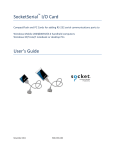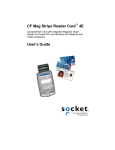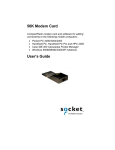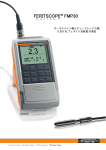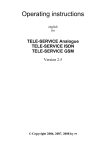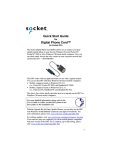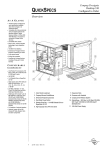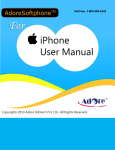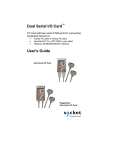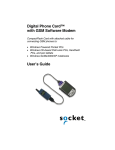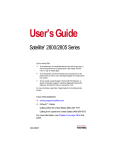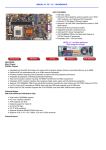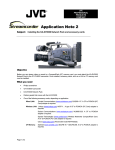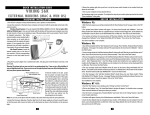Download Socket CF 56K Modem Card User`s Guide
Transcript
56K Modem Card CompactFlash modem card for providing 56K dial-up network access to the following mobile computers: • Pocket PCs, HPCs, and pen tablets running Windows Mobile • Windows 98SE/Me/2000/XP Notebooks • Windows XP Tablet PCs User’s Guide 11/2005 Document # 6410-00168 M Copyright Notice Copyright © 2005 Socket Communications, Inc. All rights reserved. Socket, the Socket logo and Mobility Friendly are registered trademarks of Socket Communications, Inc. 56K Modem Card is a trademark of Socket Communications, Inc. All other brand and product names are trademarks of their respective holders. The 56K Modem Card includes technology licensed under United States Patent Nos. 4,543,450, 4,603,320, 4,686,506, and 4,972,470. Reproduction of the contents of this manual without the permission of Socket Communications is expressly prohibited. Please be aware that the products described in this manual may change without notice. Feel free to contact SOCKET COMMUNICATIONS at: Socket Communications, Inc. 37400 Central Court Newark, CA 94560 Other than the above, Socket Communications can assume no responsibility for anything resulting from the application of information contained in this manual. Socket Communications requests that you refrain from any applications of the 56K Modem Card that are not described in this manual. Socket Communications also requests that you refrain from disassembling the product. Disassembly of this device will void the product warranty. You can track new product releases, software updates and technical bulletins by visiting Socket’s web page at: www.socketcom.com. 2 Table of Contents 1 | INTRODUCTION About Socket’s Software System Requirements Package Contents Product Registration About LEDs and Switches 2 | SETUP FOR WINDOWS MOBILE 4 4 5 5 5 5 6 STEP 1: Prepare Dial-up Information STEP 2: Install the Software (OPTIONAL) STEP 3: Complete the Connection Setup Wizard STEP 4: Connect to a Telephone Line STEP 5: Dial and Connect OPTIONAL: Use Socket Modem Utilities OPTIONAL: Check Connection Time 6 7 10 11 12 18 19 3 | SETUP FOR WINDOWS 98SE/ME/2000/XP 20 STEP 1: Prepare Dial-up Information STEP 2: Insert the Card STEP 3: Install the Drivers STEP 4: Set up Your Dial-up Connection STEP 5: Connect to a Telephone Line STEP 6: Dial and Connect OPTIONAL: Set up Advanced Networking 20 21 22 24 26 26 27 APPENDICES A | SPECIFICATIONS 29 B | NETWORK INFORMATION 30 C | ADVANCED SOFTWARE INSTALLATION 31 D | MANUAL CONNECTION SETUP 32 E | TECHNICAL SUPPORT 46 LIMITED WARRANTY 47 REGULATORY COMPLIANCE 49 3 1 | Introduction The Socket 56K Modem Card allows you to transform your mobile computer into a portable data communications tool. Now you can check email, fax, and browse the web wherever there is an available analog telephone line. The 56K Modem Card plugs directly into your mobile computer and provides a durable physical connection to an analog phone line. This User’s Guide describes how to set up and use the 56K Modem Card. For advanced users, there are also tips on connecting to a RAS server. About Socket’s Software Socket developed special software expressly for Windows Mobile, including support for square screens and landscape mode. Installing the software is optional for most devices and offers enhanced features described below. Note: For notebook computers, no software installation is necessary. Follow Socket’s Connection Setup wizard to quickly and easily set up a dial-up connection to your Internet Service Provider or work network. After you set up your modem connection, the wizard links you directly to the Windows Mobile connection manager, so you can start using your connection. Socket’ s Modem Utilities enables international travelers to program the Socket 56K Modem Card for different country codes. Plus, Socket’s status indicator applet puts a modem status icon in the status bar of your device, so you can easily monitor the modem’s connection time. Software updates: www.socketcom.com/support/support_56k.asp 4 System Requirements Your mobile computer should meet these minimum requirements: • Any of the following types of mobile computers: - Pocket PC, Handheld PC or pen tablet running Windows Mobile 5.0, Windows Mobile 2003/2003SE, or Windows CE 3.0 or greater - Windows 98SE/Me/2000/XP notebook with a 3.3V Cardbus slot. This includes virtually any notebook computer built in the last several years - Windows XP Tablet PC • Available CompactFlash or PC Card slot (PC Card adapter required for operation in PC Card slot.) • Windows Mobile/CE: ActiveSync 4.0 or greater is required to install the software. If your device already has modem drivers, software installation is optional. Sharp Zaurus compatibility, visit: www.socketcom.com/ZaurusSharp.asp Note: This is provided as Third Party information only. Socket does not officially support or provide technical support for the Sharp Zaurus. Package Contents • • • Socket 56K Modem Card Retractable RJ-11 cable Socket 56K Modem Installation CD Product Registration Socket highly recommends that all customers register their Socket products. Registered users receiver priority for technical support, product updates, and special offers. To register your product, visit: www.socketcom.com/prodreg About LEDs and Switches LED Data Status Link Status LED Activity Meaning Off Not connected Blinking Green Dialing or connected. Off Not connected Solid Green Connected CHAPTER 1: INTRODUCTION 5 2 | Setup for Windows Mobile This chapter explains how to install and use the 56K Modem Card with a Pocket PC, Handheld PC or pen tablet running any of the following: • Windows Mobile 5.0 • Windows Mobile 2003/2003SE • Windows CE 3.0 or greater Setup Summary STEP 1: Prepare dial-up information. STEP 2: Install the software (optional). STEP 3: Complete the connection wizard. STEP 4: Connect to a telephone line. STEP 5: Dial and connect. OPTIONAL: Use Socket Modem Utilities OPTIONAL: Check connection time. STEP 1: Prepare Dial-up Information Find out the following dial-up information. If needed, contact your network administrator or ISP. You need this information to set up a connection. Dial-up number: (_____) _______________________________ User name: __________________________________________ Password: ___________________________________________ Note: For most users, only the information above is necessary. If you are an advanced user and want to perform a more detailed setup, then complete the Network Information Form in Appendix B. After installing the software, refer to Appendix C to manually create a dial-up connection. 6 STEP 2: Install the Software (OPTIONAL) Socket’s modem software is only necessary for Pocket PCs running Windows Mobile 5.0 or Windows Mobile 2003/2003SE that do not have any built-in modem drivers. For all other devices, software installation is optional and offers these enhanced features: • A Connection Setup Wizard, which helps you set up a dialup connection for the modem • An applet that reports your connection time • Socket’s Modem Utilities, which enable international travelers to program the modem for different county codes. CHAPTER 2: SETUP FOR WINDOWS MOBILE 7 If you do not want to install Socket’s software — Go ahead and insert the card into your device. Skip Steps 3-4 and refer to Appendix D to manually set up a dial-up connection in Windows. To install Socket’s software, follow these instructions: IMPORTANT! − Make sure to install the software BEFORE inserting the modem card. − Make sure you have ActiveSync 4.0 or greater. Download it from www.socketcom.com/activesync. Note: Advanced installation instructions are in Appendix C. 1. Use ActiveSync and a serial/USB/Ethernet cable or cradle to make an active connection between the mobile computer and a host PC. ActiveSync should report that you have Connected, and the ActiveSync icon should turn green. Pocket_PC 2. Insert the Socket 56K Modem Installation CD into the host PC. 3. Use My Computer or Windows Explorer to access your CD-ROM drive. Click on SETUP.EXE. 8 4. The Setup program for the Socket modem software will appear. Follow the instructions on your screen until installation is complete. 5. When installation is complete, your device will prompt you to remove the device from the cradle and soft reset. Tap ok. 6. Windows Mobile 5.0: Your device will report that installation was successful. Tap ok. 7. Remove your device from the cradle and press the reset button. CHAPTER 2: SETUP FOR WINDOWS MOBILE 9 STEP 3: Complete the Connection Setup Wizard Note: If you did not install Socket’s software, refer to Appendix D for instructions on manually creating a dial-up connection in Windows. 1. If your device is still connected to your host PC, remove it from the cable/cradle. 2. Tap Start | Settings | Connections. Tap on the Connection Setup icon. 3. In next screen, select 56K Modem Connection. Tap Next>. 4. Follow the next screens to enter a name for your connection and enter your user name, password, and dial-up number 10 5. When prompted, insert the modem card and tap OK. Make sure the card is right-side up. Push the card all the way in. If using a PC Card slot, first plug the card into a PC Card adapter. WARNING! Do NOT insert the card upside down, or damage may occur! When you insert the card, the Data Status LED will blink then turn off. Note: If a bubble appears reporting that there are no connections on your device that use the modem card, tap Dismiss. 6. The last screen will report that you have completed the wizard. Now you are ready to connect to a phone line and dial. Tap on the link to go to the Remote Networking application. STEP 4: Connect to a Telephone Line Connect your modem to an analog telephone line. WARNING! Do not plug the modem into a digital PBX line. The modem will not work and may be damaged. CHAPTER 2: SETUP FOR WINDOWS MOBILE 11 STEP 5: Dial and Connect Pocket PC running Windows Mobile 5.0 or 2003/2003SE Socket recommends using either of two methods for dialing into your network. METHOD 1: Use the Connection Manager 1. Tap Start | Settings | Connections | Connections. 2. Tap Manage Existing Connections. 3. Tap and hold your stylus on the dial-up connection you created for the Socket 56K Modem Card. In the pop-up menu, tap Connect. Windows Mobile 2003/2003SE only: − Alternatively, you can tap on the Connection icon in the navigation bar at the top of the screen. It should have an “X” to show that you are not connected. − A bubble should appear with the dial-up connection you just created. Verify the phone number, then tap on the phone number. Note: If a bubble appears reporting that there are no connections on your device that use the modem card, tap Dismiss. Wait several seconds and tap on the connection icon again. 12 4. If you did not use the Connection Setup Wizard, the Network Log On screen may appear. Enter the Password and tap OK. 5. The device will begin dialing. The Power and Data LEDs will blink. When the Pocket PC has connected, the Link Status LED will stay on, and the Data Status LED will blink during data transmission. A connection icon will appear at the top of the screen to indicate the connection. If you installed Socket’s software, a modem status icon will appear in the task tray at the bottom of the Today screen. The icon will be green when connected but not transmitting data and red when transmitting data. CHAPTER 2: SETUP FOR WINDOWS MOBILE 13 METHOD 2: Dial automatically from your application Note: After you have set up a dial-up connection, the Connection Manager will automatically try to connect whenever you insert the card and try to use Pocket Internet Explorer, Pocket Inbox, or any other program that uses a dial-up connection. 1. Start the program that uses a dial-up connection. Enter a request for receiving and/or transmitting information (e.g., in Pocket Internet Explorer, enter a new URL and tap “Go”). The Pocket PC will automatically try to connect. Note: If the phone number of dialing location is wrong, tap Settings. Tap Manage Connections and Edit the properties of your connection. 2. If you did not use the Connection Setup wizard, the Network Log On screen may appear. Enter the Password and tap OK. 3. When the Pocket PC tries to connect, the Data LED will blink. When the it has connected, the Link Status LED will stay on, and the Pocket PC will receive/transmit the information as requested (e.g., Pocket Internet Explorer will display the requested website). A connection icon will appear at the top of the screen. If you installed Socket’s software, a modem status icon will appear in the task tray at the bottom of the Today screen. The icon will be green when connected but not transmitting data and red when transmitting data. Ending a Data Call 1. Tap on the connection icon in the navigation bar at the top of your screen. 2. In the status screen, tap Disconnect. The connection icon will disappear, and the modem status icon will turn red before disappearing. 14 Pocket PC 2002 1. If you just completed Socket’s Connection Setup Wizard and tapped on the link in the last screen, the Connections screen will appear. To access this screen any time, tap: Start | Settings | Connections | Connections. 2. If you have multiple modem connections set up on your Pocket PC, tap Modify… Tap and hold your stylus on the connection for the Socket 56K Modem Card and in the pop-up menu tap Always Dial. Tap ok. 3. In the top field, select Internet Settings. Tap Connect. 4. The Network Log On screen will appear. Make sure the correct User name and Password are entered. Note: You may need to modify your dial properties. Refer to your Pocket PC user manual for instructions. 1. Tap OK. Connection status screens will appear. When the Pocket PC tries to connect, the Data LED will blink. When it has connected, the Link Status LED will stay on, and the Data Status LED will blink during data transmission. ). A connection icon will appear at the top of the screen. If you installed Socket’s software, a modem status icon will appear in the task tray at the bottom of the Today screen. The icon will be green when connected but not transmitting data and red when transmitting data. Ending a Data Call 1. Go to Start | Today. Tap on the connection icon in the navigation bar at the top of your screen. 2. In the status screen, tap End. The connection icon will disappear, and the modem status icon will turn red before disappearing. CHAPTER 2: SETUP FOR WINDOWS MOBILE 15 Pocket PC 2000 1. Go to Start | Programs | Connections. Tap on the icon for the modem connection you created via the Connection Setup wizard. 2. In the next screen, make sure the correct User name and Password are entered. In Dial from: select the appropriate location: • Home: Select this if you DO NOT need to dial a number to use an external line. • Work: Select this is you DO need to dial a number to use an external line. You may need to modify the dial properties. For instructions, refer to your Pocket PC’s Make sure the correct Phone number is listed. To modify, tap on the number. 3. Tap Connect. Call status screens will appear. When the Pocket PC tries to connect, the Data LEDs will blink. When IT has connected, the Link Status LED will stay on, and the Data Status LED will blink during data transmission. A Connection icon will appear at the bottom of the Today screen. If you installed Socket’s software, a modem status icon will appear in the task tray at the bottom of the Today screen. The icon will be green when connected but not transmitting data and red when transmitting data. Ending a Data Call 1. Go to Start | Today. Tap on the connection icon in the task tray. 2. In the status screen, tap Disconnect. The task tray icons will disappear. 16 Handheld PC 2000 1. Go to Start | Programs | Communication | Remote Networking. Tap on the icon for the modem connection you created via the Connection Setup wizard. 2. In the next screen, verify the connection information. 3. For some mobile computers, you must modify the dial properties. For instructions, refer to the mobile computer’s user manual. 4. Tap Connect. Call status screens will appear. When the device tries to connect, the Data LED will blink. When the device has connected, the Link Status LED will stay on, and the Data Status LED will blink during data transmission. A Connection icon will appear in the task tray at the bottom of your screen. If you installed Socket’s software, a modem status icon will appear in the task tray at the bottom of the Today screen. The icon will be green when connected but not transmitting data and red when transmitting data. Ending a Data Call 1. Tap on the connection icon in the task tray: 2. In the status screen, tap Disconnect. After the mobile computer disconnects, the task tray icons will disappear. CHAPTER 2: SETUP FOR WINDOWS MOBILE 17 OPTIONAL: Use Socket Modem Utilities IMPORTANT: Before you use the Modem Utilities, make sure the modem is NOT currently connected to a network. 1. Pocket PC: Tap Start | Settings | System | Socket Modem Utilities HPC 2000: Tap Start | Settings | Control Panel |Socket Modem Utilities 2. The Socket Modem Utilities screen will appear. 3. If your Socket Modem Card is currently inserted into your device, your device will begin communicating with the modem. If the Socket Modem Card is not in your device, insert it now. 4. In the Current location field, select the country where you would like to dial from. Tap ok. Note; The Speaker Volume and V.92 fields will be disabled for the CF 56K Modem Card. 18 OPTIONAL: Check Connection Time Pocket PC running Windows Mobile 5.0 or 2003/2003SE The Connection Manager reports the connection time. Tap on the connection icon in the Navigator bar to access the Connectivity bubble. Pocket PC 2000/2002 and HPC 2000 Socket’s software includes a status indicator applet that lets you quickly view the modem connection’s time elapsed. This applet appears only if you have an active connection. 1. Pocket PC Devices only: Go to Start | Today. 2. Tap on the modem status icon in the task tray. 3. A screen will appear, reporting the connection time. CHAPTER 2: SETUP FOR WINDOWS MOBILE 19 3 | Setup for Windows 98SE/Me/2000/XP This chapter explains how to install and use the 56K Modem Card with a notebook computer running Windows 98SE/Me/2000/XP. Please note that the Socket modem software does not work with Windows notebooks. Setup Summary STEP 1: Prepare dial-up information. STEP 2: Insert the card. STEP 3: Install the drivers. STEP 4: Set up your dial-up connection. STEP 5: Connect to a telephone line. STEP 6: Dial and connect. OPTIONAL: Set up advanced networking. STEP 1: Prepare Dial-up Information Find out the following dial-up information. If needed, contact your network administrator or ISP. You need this information to set up a connection. Dial-up number: (_____) _______________________________ User name: __________________________________________ Password: ___________________________________________ Note: For most users, only the information above is necessary. If you are an advanced user and want to perform a more detailed setup, then complete the Network Information Form in Appendix B. 20 STEP 2: Insert the Card 1. Insert the 56K Modem Card into a CompactFlash-to-PC Card adapter. 2. With the computer turned ON, insert the combined unit into the PC Card slot of your computer. 3. After a few seconds, a new hardware or device driver wizard will automatically launch. Proceed to Step 4 to complete the wizard to install the drivers. Warning! Do NOT insert the card upside down, or damage may occur! When you insert the card, the Data Status LED will blink once then turn off. CHAPTER 3: SETUP FOR WINDOWS 98SE/Me/2000/XP 21 STEP 3: Install the Drivers After you insert the 56K Modem Card, a new hardware wizard will automatically launch for you to install a Standard PCMCIA Card Modem. Follow the wizard to install the card drivers. Windows XP 1. In the first screen, the following option should be selected: Install the software automatically (Recommended). Click Next>. Note: You do NOT need to insert an installation CD or download any drivers. 2. Your computer will search for and install the drivers. 3. In the last screen, click Finish. 22 Windows 2000, Me, and 98SE 1. The welcome screen will appear. Click Next>. 2. In the next screen, make sure the Recommended option is selected: • Windows 2000: Search for a suitable driver for my device. • Windows Me/98SE: Search for the best deriver for your device. Click Next>. Note: You do NOT need to insert an installation CD or download any drivers. 3. In the next screen UNCHECK all boxes and click Next>. 4. After Windows has found a suitable driver, click Next>. 5. Windows will install the drivers. In the last screen, click Finish. CHAPTER 3: SETUP FOR WINDOWS 98SE/Me/2000/XP 23 STEP 4: Set up Your Dial-up Connection To set up your dial-up connection, use the network connection wizard included with Windows. Windows XP and 2000 Note: Windows XP screens are shown. Windows 2000 screens will be functionally equivalent except where otherwise noted. 1. Start the Network Connection Wizard. • Windows XP: Go to Start | Control Panel | Network Connections. Under Network Tasks, click Create a new connection. • Windows 2000: Go to Start | Settings | Network and Dial-up Connections. Double-click on the Make New Connection. 2. Windows 2000: The Location Information screen will appear if you have not yet configured your dialing location information. Enter the correct settings and click Next>. 3. The New Connection Wizard will begin. Follow the wizard to create a new dial-up connection, making the following selections as prompted: Windows XP: • For Network Connection Type, select Connect to the Internet. • In the next screen, select Set up my connection manually. • In the next screen, select Connect using a dial-up modem. • In the next screen, select your PCMCIA modem. • In the next few screens, enter your dial- up settings, including a name for the connection, the dial-up number, user name, password, and user privileges. • In the last screen, click Finish. Windows 2000: • For Network Connection Type, select Dial-up to the Internet. • In the next screen, select I want to set up my Internet connection manually… • In the next screen, select I connect through a phone line and a modem. • In the next few screens, enter your dial- up settings, including a name for the connection, the dial-up number, user name, and password. • When prompted, set up an Internet mail account if desired. • In the last screen, click Finish. 24 Windows Me and 98SE • Go to Start | Settings | Dial-up Networking. Double-click on the Make New Connection icon. • The Make New Connection Wizard will begin. In the first screen, enter a name for the dial-up connection. In the Select a device field, select Standard PCMCIA Card Modem. Click Next>. • In the next screen, enter the dial-up number and country code. Click Next>. • The next screen will report that you have successfully created a new dial-up connection. Click Finish. CHAPTER 3: SETUP FOR WINDOWS 98SE/Me/2000/XP 25 STEP 5: Connect to a Telephone Line With the card still in your computer, connect to an analog telephone line. STEP 6: Dial and Connect 1. After setting up your dial-up connection in Step 4, your new connection should be listed in the network connections screen. Double-click on your new modem connection. 2. In the Connect To screen, make sure the correct User name, Password, and other connection information are entered. If necessary, create a new dialing location to make sure the correct area code and/or other dialing prefixes are used. Click Connect. 3. A series of screens will appear, reporting the status of your call. The Data Status LED will blink. When the computer has connected, the status screen will report Connected. When your computer has connected, the Link Status LED will stay on, and the Data Status LED will blink during data transmission. 4. To end a data call, in the connection status screen, tap Disconnect. 26 OPTIONAL: Set up Advanced Networking Follow the steps below to set up a dial-up connection for a RAS server. Advanced setup is necessary only if your network does NOT use DHCP (Dynamic Host Configuration Protocol). 1. Complete the Network Information Form in Appendix B. 2. To enter TCP/IP settings, after completing the wizard to create a new dial-up connection in Step 5, follow these steps to modify the connection: Windows XP (a) After completing the wizard in Step 5, the Connect screen will appear for your new connection. Click on Properties. (b) Click on the Networking tab. Check Internet Protocol and click on Properties. (c) Enter any necessary settings. If needed, click on the Advanced button to enter DNS, WNS or other settings. When done, click OK. (d) Click OK again in the main properties screen. (e) Restart your computer to make sure the changes take effect. CHAPTER 3: SETUP FOR WINDOWS 98SE/Me/2000/XP 27 Windows 2000 (a) Right-click on the icon for the connection you just created. In the pop-up menu, select Properties. (b) Click on the Networking tab. Check Internet Protocol and click on Properties. (c) Enter any necessary settings. If needed, click on the Advanced button to enter DNS, WNS or other settings. When done, click OK. (d) Click OK again in the main properties screen. Restart your computer to make sure the changes take effect. Windows Me (a) Right-click on the icon for the connection you just created. In the pop-up menu, select Properties. (b) Click on the Networking tab. Click on the TCP/IP Settings button. (c) Enter any necessary settings, then click OK. (d) Click OK again in the main properties screen. Restart your computer to make sure the changes take effect. Windows 98SE (a) Right-click on the icon for the connection you just created. In the pop-up menu, select Properties. (b) Click on the Server Types tab. Click on the TCP/IP Settings button. (c) Enter any necessary settings, then click OK. (a) Click OK again in the main properties screen. Restart your computer to make sure the changes take effect. 28 Appendix A Specifications Physical Characteristics: CF I/O Card Size: 88 x 42.8 x 14.8 mm Power Consumption (DC 3.3V): Active: 119 mA Inctive: 13 mA Interface Standards: • CompactFlash Interface: CompactFlash I/O, Type I Extended • With CompactFlash-to-PC Card Adapter: PCMCIA, Type II • Serial Communications: TTL • Transmit Speed: Up to 33.6 Kbps Receive Speed: Up to 56 Kbps • Data Modulation: ITU V.90, 56Kflex • Fax: Send/receive 14.4 Kbps ITU-T V.17, V.24, V.27 + err, V.21 Channel 2 • Error Correction: MNP Levels 2-4 ITU V.42 • Data Compression: MNP Level 5 ITU V.42 • Line Requirement: Public Switched Telephone Network (PSTN). Analog phone line only. • Receiver Sensitivity: 0-43 dBm Hardware Compatibility: Standard Card (without PC Card adapter): Pocket PC, HPC or pen tablet with CompactFlash slot running any of the following: • Windows Mobile 5.0 or Windows Mobile 2003/2003SE • Windows CE 3.0 or greater With CompactFlash-to-PC Card adapter: • Pocket PC, HPC or pen tablet with PC Card slot running any of the following: - Windows Mobile 5.0 or Windows Mobile 2003/2003SE - Windows CE 3.0 or greater • Windows 98SE/Me/2000/XP notebook with Cardbus. • Windows XP Tablet PC Sharp Zaurus compatibility — visit: www.socketcom.com/ZaurusSharp.asp Note: This is provided as Third Party information only. Socket does not provide technical support for the Sharp Zaurus. Software Included: Socket 56K Modem Installation CD Warranty: Certification: CompactFlash Card: Three years FCC: Part 15, Class B JATE ID: A03-0532JP CE: ET-928-07-007 CompactFlash Spec. 2.0 Telecom Approval: FCC: Part 68, CTR 21 APPENDIX A: SPECIFICATIONS | 29 Appendix B Network Information Network Information Form For Advanced Users Only Contact your office network administrator or Internet Service Provider (ISP) for the information below. For a text-only form that you can email to your network administrator or ISP, visit: www.socketcom.com/pdf/56kform.txt 1. Please provide the following dial-up information: Dial-up number: ( ____ ) _______________ User name: _________________________ Password: _________________________ Domain: __________________________ 2. Does the network support DHCP (Dynamic Host Configuration Protocol)? YES. If Yes, then STOP. You do NOT need to answer Question 3. NO. If No, then continue to Question 3. You may need only some of the IP addresses listed below. 3. Please specify any applicable IP addresses: (a) Mobile Computer IP address: _____ . _____ . _____ . _____ (b) Subnet Mask: _____ . _____ . _____ . _____ (c) Default Gateway: _____ . _____ . _____ . _____ (d) Primary DNS: _____ . _____ . _____ . _____ (e) Secondary DNS: _____ . _____ . _____ . _____ (f) Primary WINS: _____ . _____ . _____ . _____ (g) Secondary WINS: _____ . _____ . _____ . _____ 30 | APPENDIX B: NETWORK INFORMATION FORM Appendix C Advanced Software Installation for Windows Mobile Advanced Users Only! If you do not want to use the application installer to install Socket’s modem software, you can install the software from a CAB (cabinet) file. The CAB file contains all the software and drivers for your product to be installed on a specific Pocket PC platform. CAB files are available both on the installation CD (in the CABs folder) and at: www.socketcom.com/support/support_56k.asp?Type=Modem In order to install the CAB file, you need a way to transfer the CAB file to your Pocket PC, such as: • Use Microsoft ActiveSync to transfer the CAB file to your Pocket PC. Windows Mobile 5.0 devices require ActiveSync 4.0 or greater. • Use a memory card reader to save the CAB file from your desktop PC to a memory card, then insert the memory card into your Pocket PC. • If your Pocket PC has Internet access, download the CAB file directly from Socket’s website to your Pocket PC. 1. Transfer the correct CAB file to your Pocket PC. Refer to the chart below to determine the correct CAB file for your Pocket PC. If transferring the CAB file with ActiveSync or downloading the CAB file directly to your Pocket PC, remember where you save the file. Pocket PC Version 2005 (Windows Mobile 5.0) 2003/2003SE 2002 CAB File Output.PPC2005ARMV4I Output.PPC2203ARMV4 Output.PPC2002ARM 2. Tap Start | Programs | File Explorer. 3. Use File Explorer to browse to the CAB file. Tap on the CAB file. 4. The CAB file will start installing on your Pocket PC. Follow the instructions on your device screen to install the software. 5. Your device may warn that the CAB file comes from an unknown publisher. Tap Yes to continue installation. 6. After software installation, soft reset your device by pressing the reset button. APPENDIX B: NETWORK INFORMATION | 31 Appendix D Manual Connection Setup If you did not install Socket’s software, or if you do not want to use the Connection Setup wizard, you can manually set up a dial-up connection in Windows Mobile. The process differs between a Pocket PC 2000/2002/2003/2003SE and Handheld PC 2000. In the following pages, find the instructions for your specific type of mobile computer. You will need your dial-up information for this step. For most devices, this step involves two separate parts: making a new connection and entering the dialing settings. Pocket PC running Windows Mobile 5.0 or 2003/2003SE Note: These instructions are for setting up a standard dial-up connection to an Internet Service Provider (ISP). If you want to connect to your work network and/or a VPN/proxy server, refer to your Pocket PC manual. 1. Tap Start | Settings | Connections. Tap on Connections. 2. Tap on the Advanced tab. Tap Select Networks. 32 | APPENDIX C: MANUAL CONNECTION SETUP 3. In the Network Management screen, make sure My ISP is selected in the top field, and My Work Network is selected in the bottom field. Tap ok. 4. Tap on the Tasks tab. In most cases, you should tap Add a new modem connection under My ISP. 5. In the next screen, enter the following: • Enter a name…: Enter a name for the new modem connection. • Select a modem: Socket 56K Modem or Socket-CF+_ 56K_Modem. Tap Next. APPENDIX C: MANUAL CONNECTION SETUP | 33 6. In the next screen, enter the dial-up number exactly how it should be dialed from your current location. You can enter the number without any spaces or dashes. Note: If you plan to use the connection in different area codes, tap use dialing rules to set up the correct dialing locations. Refer to your Pocket PC manual for instructions. 5. In the next screen, enter the User name and Password. Tap Advanced. 6. In the General screen, select the following: • Baud rate: 57600. • Wait for dial tone before dialing: Checked. If you DO NOT need to enter any IP addresses, tap ok. If you DO need to enter IP addresses, tap on the TCP/IP and Servers tabs to enter any necessary IP addresses. Tap ok. In the last screen, tap Finish. 34 | APPENDIX C: MANUAL CONNECTION SETUP Pocket PC 2002 Make a New Connection 1. Go to Start | Settings | Connections. Tap on Connections. 2. In the next screen, in the top field, select Internet Settings. Tap Modify… 3. In the next screen, tap New… APPENDIX C: MANUAL CONNECTION SETUP | 35 4. In the next screen, enter the following settings. • Enter a name…: Enter a name, such as “My 56K Connection.” • Select a modem: Select Socket 56K Modem or Socket-CF+_ 56K_Modem. • Baud Rate: 57600 If you DO NOT need to enter any IP addresses, tap Next. If you DO need to enter IP addresses, tap Advanced. Use the TCP/IP and Name Servers screens to enter the necessary IP addresses. Tap ok. In the next screen, tap Next. 5. Enter the dial-up number and tap Next. You can enter the phone number without spaces or dashes. Important! Be sure to enter the correct Country code, Area code and Phone number! Do not leave any field blank! 36 | APPENDIX C: MANUAL CONNECTION SETUP 6. Make sure Wait for dial tone before dialing is checked. Tap Finish. 7. In Internet Settings, if multiple connections exist, you must select the new connection to be used when dialing. In the list, tap and hold your stylus on the connection. In the pop-up menu, select Always Dial. Tap ok. If you have only one connection, then the Always Dial feature will not appear. Tap ok. After you select the modem card connection for dialing, it should be identified here. Enter Dialing Settings 1. After making the new connection, you will return to the Connections screen. Tap on the Dialing Locations tab. APPENDIX C: MANUAL CONNECTION SETUP | 37 2. In the next screen, enter the settings appropriate for your telephone line. If you DO NOT need to dial a number to use an external line, do the following: a) In the Location: field, select Home. Make sure the Area code and Country code are correct. Tap ok. Note: In most cases, users should select Home. If you DO need to dial a number to use an external line (e.g., 9), do the following: a) In the Location: field, select Work. Make sure the Area code and Country code are correct. Tap on Dialing Patterns. b) In the Dialing Patterns screen, enter the following settings, where: X represents the number for dial-out Y represents the number for dial-out long distance • • • c) For local calls, dial: X,G For long distance calls, dial: Y,1,FG (“1” for U.S.) For international calls, dial: Y,011,EFG (“011” for U.S.) Tap ok. In the Dialing Options screen, tap ok. Note: The values for X and Y may be the same, as shown.. 38 | APPENDIX C: MANUAL CONNECTION SETUP Pocket PC 2000 Make a New Connection 1. Go to Start | Settings | Connections. Tap on Modem. 2. In the next screen, tap New Connection… 3. In the next screen, enter the following settings. • Enter a name…: Enter a name, such as “My 56K Connection.” • Select a modem: Socket 56K Modem or Socket-CF+_ 56K_Modem. • Baud Rate: 57600 If you DO NOT need to enter any IP addresses, tap Next. If you DO need to enter IP addresses, tap Advanced. Use the TCP/IP and Name Servers screens to enter the necessary IP addresses. Tap ok. In the next screen, tap Next. APPENDIX C: MANUAL CONNECTION SETUP | 39 4. Enter the dial-up number and tap Next. You can enter the phone number without spaces or dashes. Important! Be sure to enter the correct Country code, Area code, and Phone number! Do not leave any field blank! 7. Make sure Wait for dial tone before dialing is checked. Tap Finish. Enter Dialing Settings 1. After making the new connection, you will return to the Connections screen. Your new connection should be listed. Tap on the Dialing tab. 40 | APPENDIX C: MANUAL CONNECTION SETUP 2. In the next screen, enter the settings appropriate for your telephone line: If you DO NOT need to dial a number to use an external line (e.g., 9), do the following: a) In the Location: field, select Home. Make sure the Area code and Country code are correct. Tap ok. Note: In most cases, users should select Home. If you DO need to dial a number to use an external line (e.g., 9), do the following: a) In the Location: field, select Work. Make sure the Area code and Country code are correct. Tap on Dialing Patterns. b) In the Dialing Patterns screen, enter the following settings, where: X represents the number for dial-out Y represents the number for dial-out long distance • For local calls, dial: X,G • For long distance calls, dial: Y,1,FG (“1” for U.S.) • For international calls, dial: Y,011,EFG (“011” for U.S.) c) Tap ok. d) In the Dialing Options screen, tap ok. Note: The values for X and Y may be the same, as shown.. APPENDIX C: MANUAL CONNECTION SETUP | 41 Handheld PC 2000 Make a New Connection 1. Go to Start | Programs | Communication | Remote Networking | Make New Connection. 2. In the Make New Connection screen, enter a name for the connection, such as “My 56K Connection.” Select Dial-Up Connection. Tap Next>. 3. The Make New Dial-Up Connection screen will appear. In the drop-down menu, select Socket 56K Modem or Socket-CF+_ 56K_Modem. Tap on Configure… 42 | APPENDIX C: MANUAL CONNECTION SETUP 4. In Port Settings, in the Baud Rate field, select 57600. Tap on the Call Options tab. 5. Make sure Wait for dial tone before dialing is checked. Tap OK. 6. The Make New Dial-Up Connection screen will appear. If you DO NOT need to enter any IP addresses, tap Next>. If you DO need to enter IP addresses, tap TCP/IP Settings. Use the General and Name Servers screens to enter any necessary IP addresses. Tap OK. In the next screen, tap Next>. 7. In the next screen, enter the phone number of your office network or ISP. Tap Finish. Important! Be sure to enter the Country code, Area code, and Telephone number! APPENDIX C: MANUAL CONNECTION SETUP | 43 Enter Dialing Properties 1. When you return to the Remote Networking screen, tap on the icon for the connection you just made. 2. In the Dial-Up Connection screen, enter your User Name and Password. Then tap on Dial Properties. 3. In the Dialing Properties screen, enter the settings appropriate for your telephone line. If you DO NOT need to dial a number to use an external line (e.g., 9), do the following: a) In the When dialing from: field, select Home. Make sure the area code and country code are correct. Tap OK. Note: In most cases, users should select Home. 44 | APPENDIX C: MANUAL CONNECTION SETUP If you DO need to dial a number to use an external line (e.g., 9), do the following: a) In the When dialing from: field, select Work. Make sure the area code and country code are correct. Tap on Dialing Patterns... b) In the Dialing Patterns screen, enter the following settings, where: X represents the number for dial-out Y represents the number for dial-out long distance • For local calls, dial: X,G • For long distance calls, dial: Y,1,FG (“1” for U.S.) • For international calls, dial: Y,011,EFG (“011” for U.S.) Note: The values for X and Y may be the same, as shown. c) Tap OK. In the Dialing Properties screen, tap OK. APPENDIX C: MANUAL CONNECTION SETUP | 45 Appendix E Technical Support If you have trouble installing or using the 56K Modem Card, Socket has two technical support resources you can use: Socket On-Demand Support (SOS) Socket On-Demand Support provides the quickest turnaround time and is the best place to start for technical support. Because it’s interactive, this automated technical support program focuses in on your specific problem to provide the specific answers you need. To access Socket On-Demand Support, please visit: www.socketcom.com/support and click on the SOS icon. If SOS cannot answer your inquiry, you will have the opportunity to submit your question(s) to a technical support engineer after the session. Your interactive session will be saved for reference. Note: To help expedite live tech support, you will be asked to register your product and provide some system configuration/environment information. Live Technical Support IMPORTANT! To obtain technical support for your product, you must first register your product online at www.socketcom.com/prodreg. After product registration, log in and click on the Technical Support tab. Click New Trouble Ticket to submit an online request for technical support. If we are unable to resolve your support inquiry via email, we can arrange for a technical support representative to call you at a specific time. You can log in anytime to track the progress of your request. Please refrain from disassembling the modem. Disassembly of this device will void the product warranty 46 | APPENDIX D: TECHNICAL SUPPORT Limited Warranty Socket Communications Incorporated (Socket) warrants this product against defects in material and workmanship, under normal use and service, for the following periods from the date of purchase:Three years Incompatibility is not a defect covered by Socket’s warranty. During the warranty period, Socket will, at its option, repair or replace the defective product at no charge when furnished with proof of retail purchase, provided that you deliver the product to Socket or to an authorized Socket Service Center. The returned product must be accompanied by a return material authorization (RMA) number issued by Socket or by Socket's Authorized Service Center. If you ship the product, you must use the original container or equivalent and you must pay the shipping charges to Socket. Socket will pay shipping charges back to any location in the contiguous United States. This warranty applies only to the original retail purchaser and is not transferable. Socket may, at its option, replace or repair the product with new or reconditioned parts and the returned product becomes Socket's property. Socket warrants the repaired or replaced products to be free from defects in material or workmanship for ninety (90) days after the return shipping date, or for the duration of the original warranty period, whichever is greater. This warranty does not cover the replacement of products damaged by abuse, accident, misuse or misapplication, nor as a result of service or modification other than by Socket. SOCKET IS NOT RESPONSIBLE FOR INCIDENTAL OR CONSEQUENTIAL DAMAGES RESULTING FROM BREACH OF ANY EXPRESS OR IMPLIED WARRANTY, INCLUDING DAMAGE TO PROPERTY AND, TO THE EXTENT PERMITTED BY LAW, DAMAGES FOR PERSONAL INJURY. THIS WARRANTY IS IN LIEU OF ALL OTHER WARRANTIES INCLUDING IMPLIED WARRANTIES OF MERCHANTABILITY AND FITNESS FOR A PARTICULAR PURPOSE. Some states do not allow limitation of implied warranties, or the exclusion or limitation of incidental or consequential damages, so that the above limitations or exclusions may not apply to you. This warranty gives you specific legal rights and you may also have other rights which vary from state to state. This product may contain fully tested, recycled parts, warranted as if new. For warranty information, phone (510) 744-2700. WARRANTY | 47 Limited Software Warranty LIMITED WARRANTY. SOCKET warrants that the original disk or CD ROM is free from defects for 90 days from the date of delivery of the SOFTWARE. CUSTOMER REMEDIES. SOCKET’S entire liability and your exclusive remedy shall be, at SOCKET’S option, either (a) return of the price paid or (b) replacement of the SOFTWARE which does not meet SOCKET’S Limited Warranty and which is returned to SOCKET with a copy of your receipt. Any replacement SOFTWARE will be warranted for the remainder of the original warranty period or 30 days, whichever is longer. THESE REMEDIES ARE NOT AVAILABLE OUTSIDE OF THE UNITED STATES OF AMERICA. NO OTHER WARRANTIES. SOCKET disclaims all other warranties, either express or implied, including but not limited to implied warranties of merchantability and fitness for a particular purpose, with respect to the SOFTWARE and the accompanying written materials. This limited warranty gives you specific legal rights. You may have others which vary from state to state. NO LIABILITY FOR CONSEQUENTIAL DAMAGES. In no event shall SOCKET or its suppliers be liable for any damages whatsoever (including, without limitation, damages for loss of business profits, business interruption, loss of business information, or other pecuniary loss) arising out of the use of or inability to use the SOFTWARE, even if SOCKET has been advised of the possibility of such damages. Because some states do not allow the exclusion or limitation of liability for consequential or incidental damages, the above limitation may not apply to you. EXPORT LAW ASSURANCES. You may not use or otherwise export or reexport the SOFTWARE except as authorized by United States law and laws of the jurisdiction in which the SOFTWARE was obtained. In particular, but without limitation, none of the SOFTWARE may be used or otherwise exported or reexported (a) into (or to a national or resident of) a United States embargoed country or (b) to anyone on the U.S. Treasury Department’s list of Specially Designated Nationals or the U.S. Department of Commerce’s Table of Denial Orders. By using the SOFTWARE, you represent and warrant that you are not located in, under control of, or a national or resident of any such country or on any such list. GOVERNMENT END USERS. If the SOFTWARE is supplied to the U. S. Government, the SOFTWARE is classified as “restricted computer software” as defined in clause 52.227-19 of the FAR. The U. S. Government ‘s rights to the SOFTWARE are as provided in clause 52.227-19 of the FAR. CONTROLLING LAW AND SEVERABILITY. This License shall be governed by the laws of the United States and the State of California. If for any reason a court of competent jurisdiction finds any provision, or portion thereof, to be unenforceable, the remainder of this License shall continue in full force and effect. 48 | WARRANTY Regulatory Compliance 1. This equipment complies with Part 68 of the FCC Rules. On the back of the 56K Modem Card is a label that contains, among other information, the FCC registration number. If requested, provide this information to your telephone company. 2. This product meets applicable Industry Canada technical specifications. 3. The registration jack USOC for the 56K Modem Card is SCIM506BSOCKETCFM. 4. The REN is useful to determine the quantity of devices that may be connected to the telephone line. Excessive RENs on the telephone line may result in the devices not ringing in response to an incoming call. In most, but not all areas, the sum of RENs of all devices should not exceed five (5). To be certain of the number of devices that may be connected to a line, as determined by the total RENs, contact the local telephone company. 5. An FCC compliant telephone cord and modular plug is provided with this equipment. This equipment is designed to be connected to the telephone network, which is Part 68 compliant. See installation instructions for details. 6. If the Socket 56K Modem Card causes harm to the telephone network, the telephone company will notify you in advance that temporary discontinuance of service may be required. But if advance notice isn't practical, the telephone company will notify the customer will be notified as soon as possible. You will be advised of your right to file a complaint with the FCC if you believe it is necessary. 7. Your telephone company may make changes in its facilities, equipment, operations, or procedures that could affect the operation of your equipment. If they do, you will be given advance notice so as to give you an opportunity to maintain uninterrupted service. 8. If you experience trouble with the Socket 56K Modem Card, please contact Socket’s technical support department for repair/warranty information. Register your product at www.socketcomc.com/prodreg and email a support request. If your equipment is causing harm to the telephone network, the telephone company may request that you disconnect the equipment until the problem is resolved. 9. For any other repairs to the device, also contact Socket’s technical support department by the method mentioned above. 10. Connection to party line service is subject to state tariffs. Contact the state public utility commission, public service commission or corporation commission for information. 49 11. If your home has specially wired alarm equipment connected to the telephone line, ensure the installation of this equipment does not disable alarm equipment, consult your telephone company or a qualified installer. Product Disposal Your device should not be placed in municipal waste. Please check local regulations for disposal of electronic products. 50 © Socket Communications, Inc. 11/2005 Printed in U.S.A.




















































